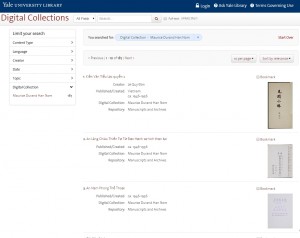On Monday 9/21/2015, YUL’s digital collection discovery interface (findit.library.yale.edu) will go live with a new design modeled on the Quicksearch interface design. These coordinating designs let our users know that they are in the same Yale University Library web space and should expect similar functionality.
The new look and feel of digital collections search at YUL- main page (click the image to get a larger view):
Search results in the new design:
There will also be a few new features in the digital collections search added on Monday. These include:
- an Access Restrictions facet, to limit by either open or restricted access

- a Repository facet, to limit to and search within a specific repository at YUL
- a Call Number facet, to limit to and search within call numbers assigned to items
Another feature coming soon (but not on Monday) is a date slider with a histogram visualization, which gives users the ability to limit by date range and see the frequency of hits in a given year. To see an example of a feature like this used elsewhere, click on this search of Articles+ and look to the lower left to see the date range and histogram.
As always, your feedback is welcomed and appreciated. Please use the feedback link on the bottom center of the digital collections search page (or just click here), and tell us your thoughts!





